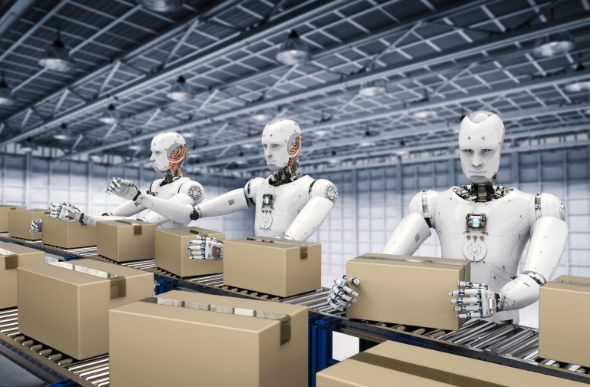What is modern Robot development technology?
Modern robot development technology has adapted and improved significantly in recent years. Here are some important trends and advances in this field:
1.Artificial Intelligence (AI) and Machine Learning: Modern robots are equipped with AI and complex machine learning algorithms, allowing them to learn from their environment and interact with humans more naturally.
2.Collaborative robots (Cobots): Collaborative robots are becoming popular in industrial work environments. They are capable of working alongside humans without requiring complex safety measures like traditional industrial robots.
3.Service and management robots: Service robots, such as automated delivery robots, tour guide robots, and smart home management robots, are becoming increasingly popular and being integrated into physical environments.
4.Sensor and Perception: Advanced sensors such as 3D cameras, lidar, and radar help robots perceive and interact with the surrounding environment more accurately and flexibly.

5.Mobile Robots and Autonomous Robots: Advances in mobile and autonomous technology are helping robots move freely in diverse environments, from industrial to urban environments.
6.Social and Emotional Robotics: Research on social and emotional robotics is being conducted to create robots capable of interacting with humans naturally and empatially.
7.Medical and health robots: Robotics technology is being widely applied in the medical field, from surgical robots to assistive robots for the disabled and the elderly.
These advances are opening up new prospects for the application of robots in many different areas of life and industry.
What are the benefits of bringing modern Robot technology into human life?
Introducing modern robot technology into human life brings many important benefits, including:
Enhance labor efficiency: Robots can perform repetitive and highly complex tasks quickly and accurately, helping to increase labor efficiency and reduce human errors.
Reduced risk and increased safety: Robots can perform dangerous or risky tasks that humans cannot safely perform, from work in industrial environments to rescue situations. urgent.
Support for people with disabilities and the elderly: Robotic technology can provide support and care for people with disabilities and the elderly in performing daily activities, from mobility to health care. Strong.
Improve quality of life: Service robots such as assistive robots in house cleaning, automated delivery, and tour guiding can help improve people’s quality of life by freeing up time and money. effort for other activities.
Reduce labor pressure: Robots can reduce labor pressure for people working in industries with harsh working environments or requiring great labor.
Creating new opportunities for innovation and development: The application of robotics technology opens up new opportunities for creativity and development in many fields, from healthcare to education and entertainment.
In short, integrating modern robot technology into human life brings many important benefits, helping to create a safer, more efficient and convenient living and working environment.
How effective is Robot technology?
The usability of robotic technology depends on many factors, including intended use, design, automation capabilities, and level of integration with the environment and user. Below are some important factors that affect the performance of robotic technology:
Flexibility and versatility: Flexible robots can adapt and perform many different tasks in diverse environments. This versatility helps optimize the robot’s performance.
Accuracy and reliability: Robots need to be highly accurate and reliable in performing their tasks. This ensures that the robot can operate efficiently and safely in the work environment.
Interaction with humans: Robots need to be able to interact with humans naturally and effectively. This interaction not only enhances productivity but also creates a better user experience.
Integration and connectivity: Good performance robots have the ability to integrate with other systems and devices, as well as the ability to connect to the internet and external data sources to improve processes. work.
Safety and security: Robots need to be designed and operated in a safe and secure manner to ensure that they do not pose a danger to humans and information systems.
Flexibility in management and maintenance: Robots need to have flexibility in management and maintenance to easily update, upgrade and repair when necessary, helping to increase the performance and lifespan of the robot.
In summary, the usability of robotic technology depends on many important factors, including flexibility, precision, interoperability, integration, safety and security, as well as flexibility in management and maintenance.
What are the disadvantages of overusing Robot technology in human life?
Although robot technology brings many benefits, overuse and reliance on robot technology also has certain disadvantages and risks:
Loss of jobs for humans: Automation through robots could lead to job losses for some people, especially in industries where jobs could be replaced by robots. This can cause problems of unemployment and social unrest.
Reduced skill and dependence: When humans rely too much on robots, they can lose their skills and ability to solve problems on their own. This dependence can reduce human creativity and adaptability in complex situations.
Information security and privacy risks: Robotic technology, especially in applications such as smart home robots and service robots, can pose issues related to information security and privacy . The collection of personal data and information can become a threat if not carefully managed and protected.
Dependence on unstable technology: Over-reliance on robotic technology can create risks when the system becomes unstable or crashes. If a robot crashes or is subject to a cyber attack, there can be serious consequences for daily operations and industry.
Cultural loss and technical loss: Dependence on robotic technology can lead to loss of culture and tradition, as well as the loss of traditional craft skills that can be an important part of heritage. cultural and technical products.
In short, the abuse of robot technology can cause many problems and risks to human life if not managed and controlled carefully.
